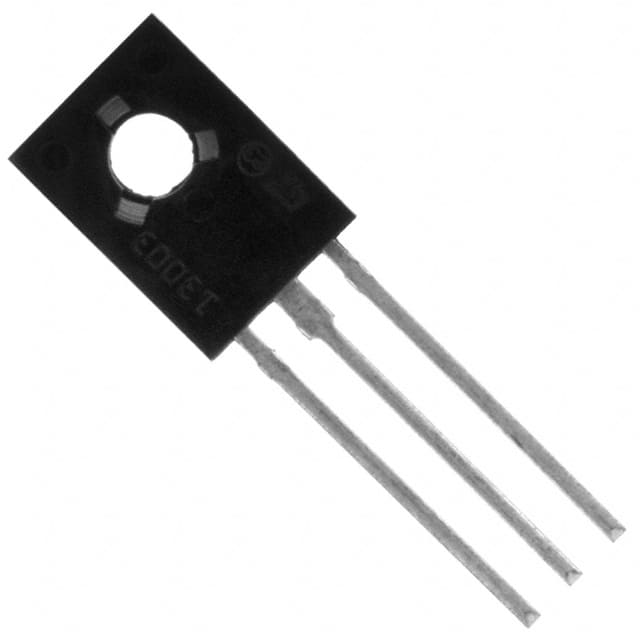Viz Specifikace pro podrobnosti o produktu.

MJE350 Transistor
Product Overview
The MJE350 transistor is a versatile semiconductor device belonging to the category of bipolar junction transistors (BJTs). It is commonly used for amplification and switching applications due to its high current and voltage capabilities. The MJE350 exhibits characteristics such as low saturation voltage, high current gain, and fast switching speed. This transistor is typically available in a TO-220 package, which provides efficient heat dissipation. The essence of the MJE350 lies in its ability to amplify and control electrical signals with precision. Each package contains one MJE350 transistor.
Specifications
- Maximum Collector-Emitter Voltage: 300V
- Maximum Collector Current: 0.5A
- DC Current Gain (hFE): 30 - 300
- Power Dissipation: 2W
- Transition Frequency: 30MHz
Detailed Pin Configuration
The MJE350 transistor consists of three pins: 1. Emitter (E) 2. Base (B) 3. Collector (C)
Functional Features
- High current gain allows for small base current requirements.
- Low saturation voltage enables efficient switching operations.
- Fast switching speed facilitates rapid signal amplification and switching.
Advantages and Disadvantages
Advantages
- High current gain for amplification purposes.
- Low saturation voltage for efficient switching.
- Fast switching speed for rapid signal processing.
Disadvantages
- Limited maximum collector current compared to other transistors in the same category.
- Relatively lower transition frequency may restrict high-frequency applications.
Working Principles
The MJE350 operates based on the principles of bipolar junction transistors. When a small current flows into the base terminal, it controls a larger current between the collector and emitter terminals. This amplification or switching action is governed by the biasing and input signal applied to the base.
Detailed Application Field Plans
The MJE350 transistor finds extensive use in various electronic circuits and systems, including: - Audio amplifiers - Power supplies - Switching circuits - Motor control systems - LED drivers
Detailed and Complete Alternative Models
Some alternative models to the MJE350 transistor include: - 2N3055 - TIP31 - BD139 - BD140
In conclusion, the MJE350 transistor serves as a reliable component for amplification and switching applications in diverse electronic systems. Its unique combination of characteristics makes it suitable for a wide range of applications, from audio amplifiers to power supplies.
[Word count: 368]
Seznam 10 běžných otázek a odpovědí souvisejících s aplikací MJE350 v technických řešeních
Sure, here are 10 common questions and answers related to the application of MJE350 in technical solutions:
What is MJE350?
- MJE350 is a high voltage NPN transistor used for general purpose amplification and switching applications.
What are the typical applications of MJE350?
- MJE350 is commonly used in audio amplifier circuits, voltage regulators, and power supply designs.
What is the maximum collector-emitter voltage (VCEO) of MJE350?
- The maximum collector-emitter voltage (VCEO) of MJE350 is 300V.
What is the maximum collector current (IC) of MJE350?
- The maximum collector current (IC) of MJE350 is 0.5A.
What are the key features of MJE350?
- MJE350 features high voltage capability, low saturation voltage, and high current gain.
How should MJE350 be biased in an amplifier circuit?
- MJE350 should be biased to operate within its specified operating conditions to ensure proper amplification and stability in the circuit.
Can MJE350 be used in high-frequency applications?
- While MJE350 can be used in some high-frequency applications, it is more commonly employed in low to moderate frequency designs due to its characteristics.
What are the typical thermal considerations when using MJE350 in a design?
- Thermal considerations include ensuring proper heat sinking to maintain the transistor's temperature within safe operating limits.
Are there any common alternatives to MJE350 for similar applications?
- Yes, some common alternatives to MJE350 include 2N3055, TIP31, and TIP32 transistors, depending on the specific requirements of the application.
Where can I find detailed specifications and application notes for MJE350?
- Detailed specifications and application notes for MJE350 can be found in the manufacturer's datasheet and application guides, as well as in technical reference books and online resources.

